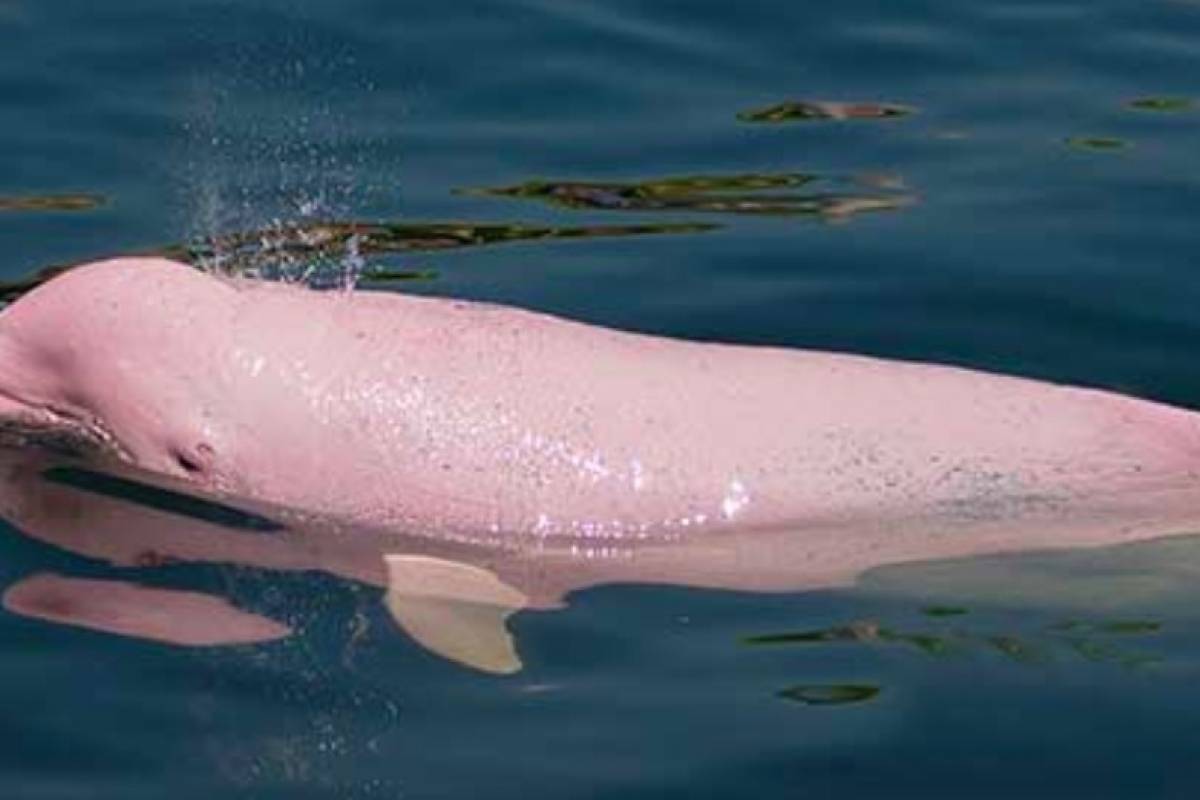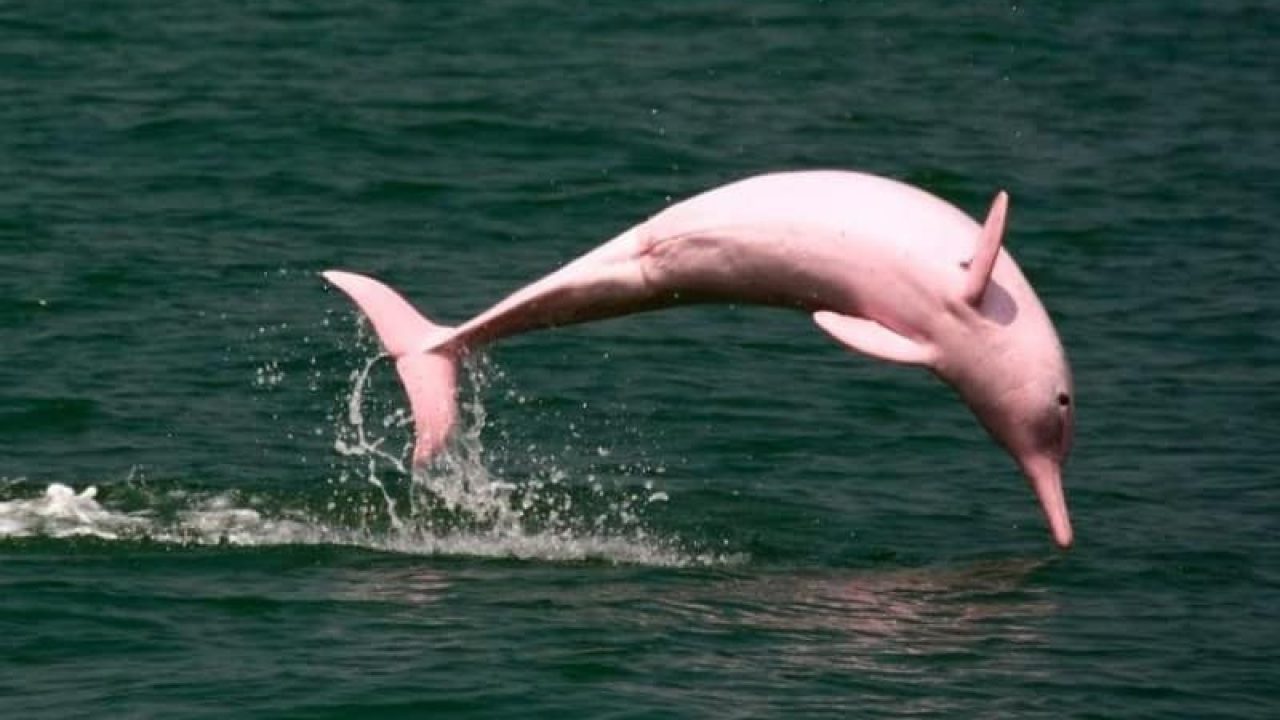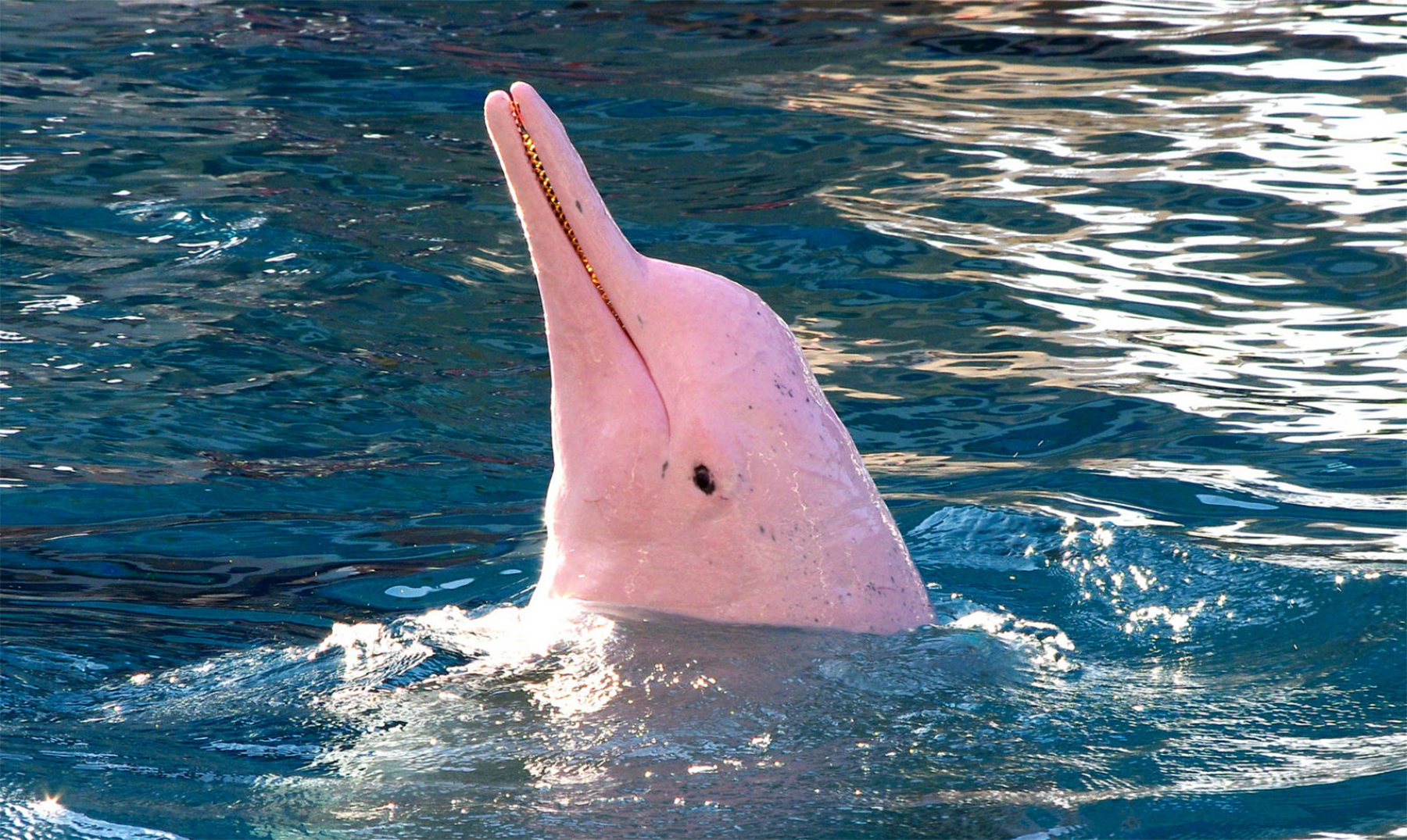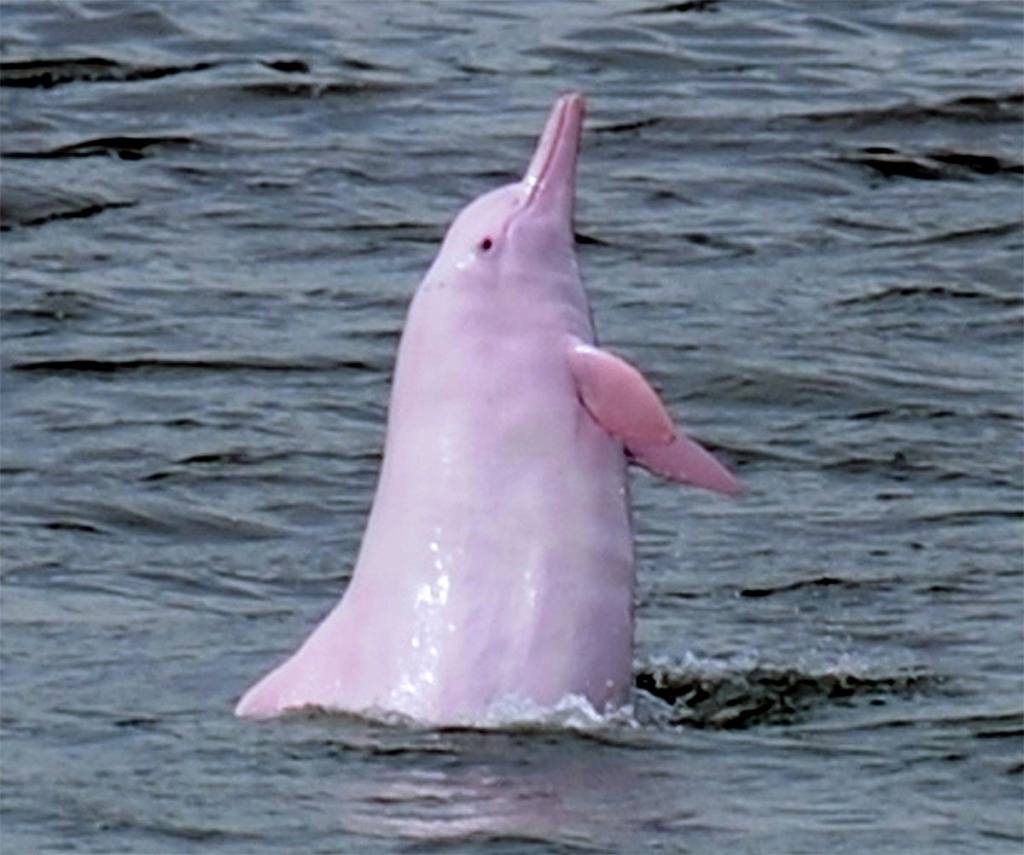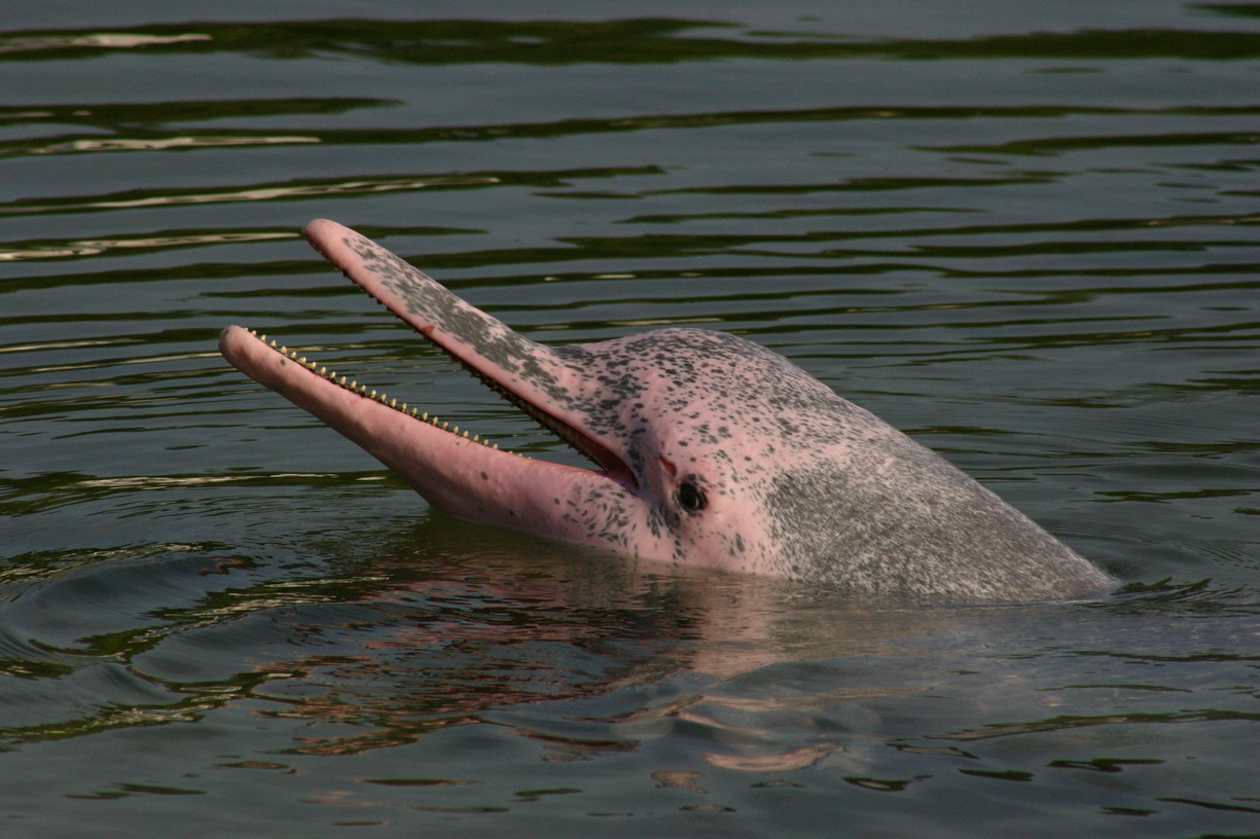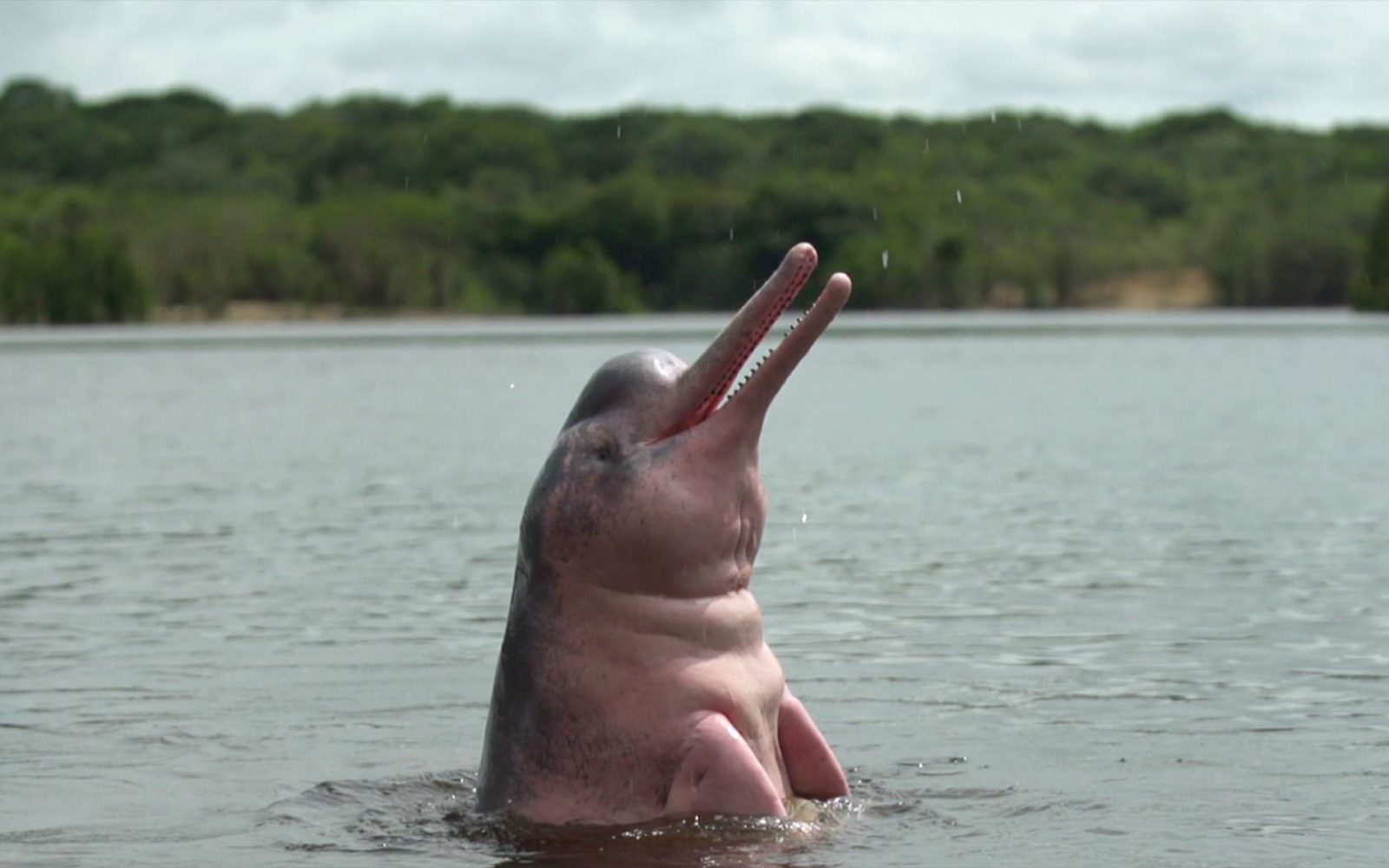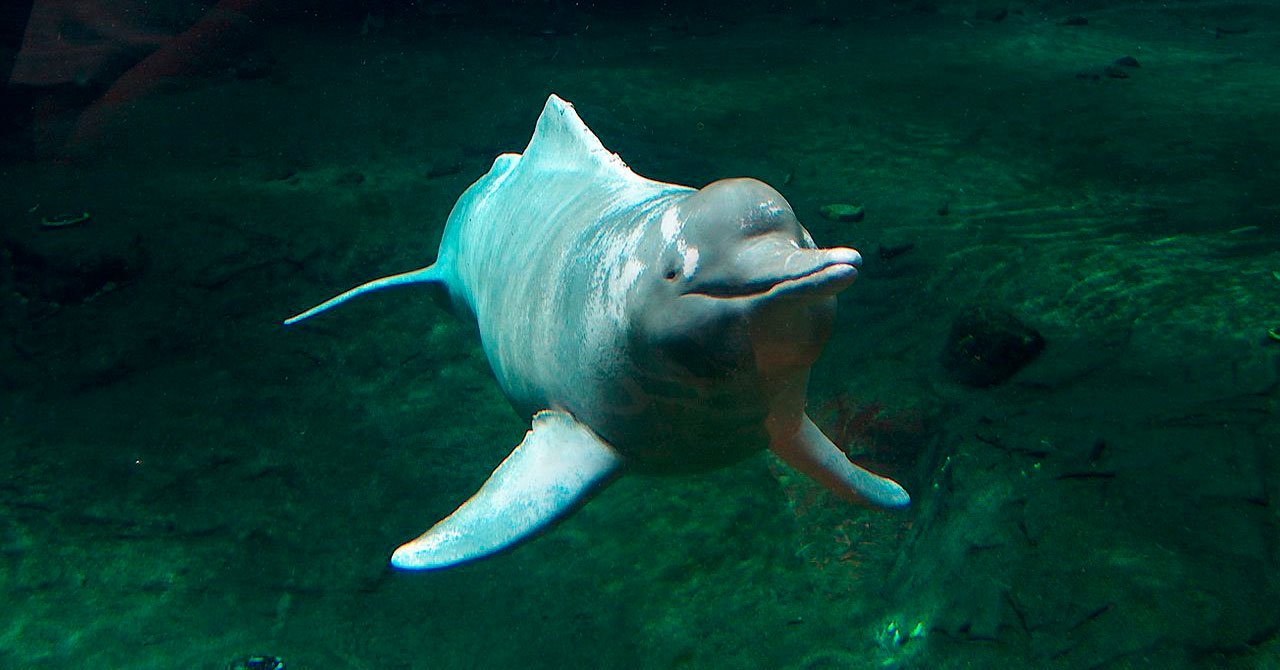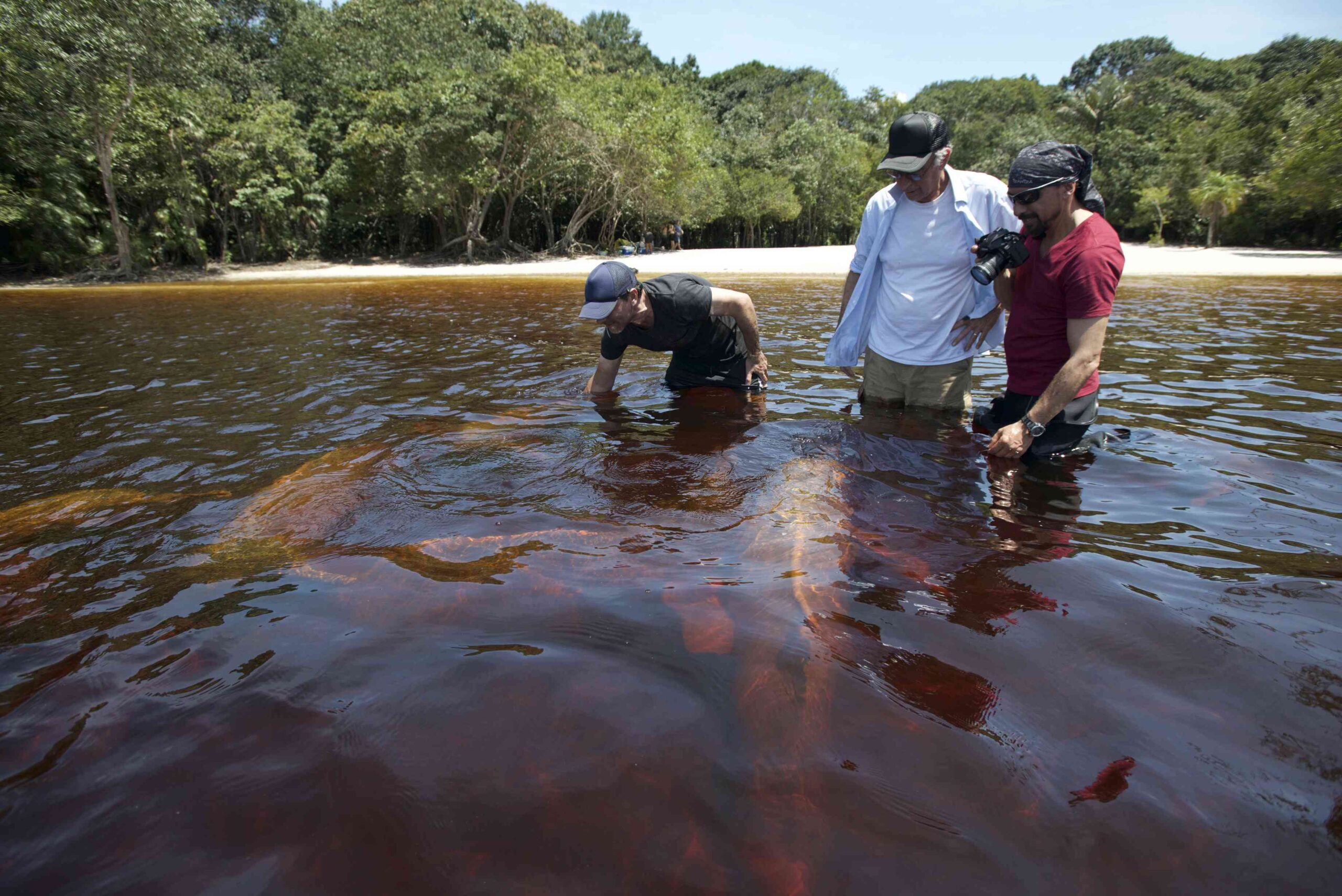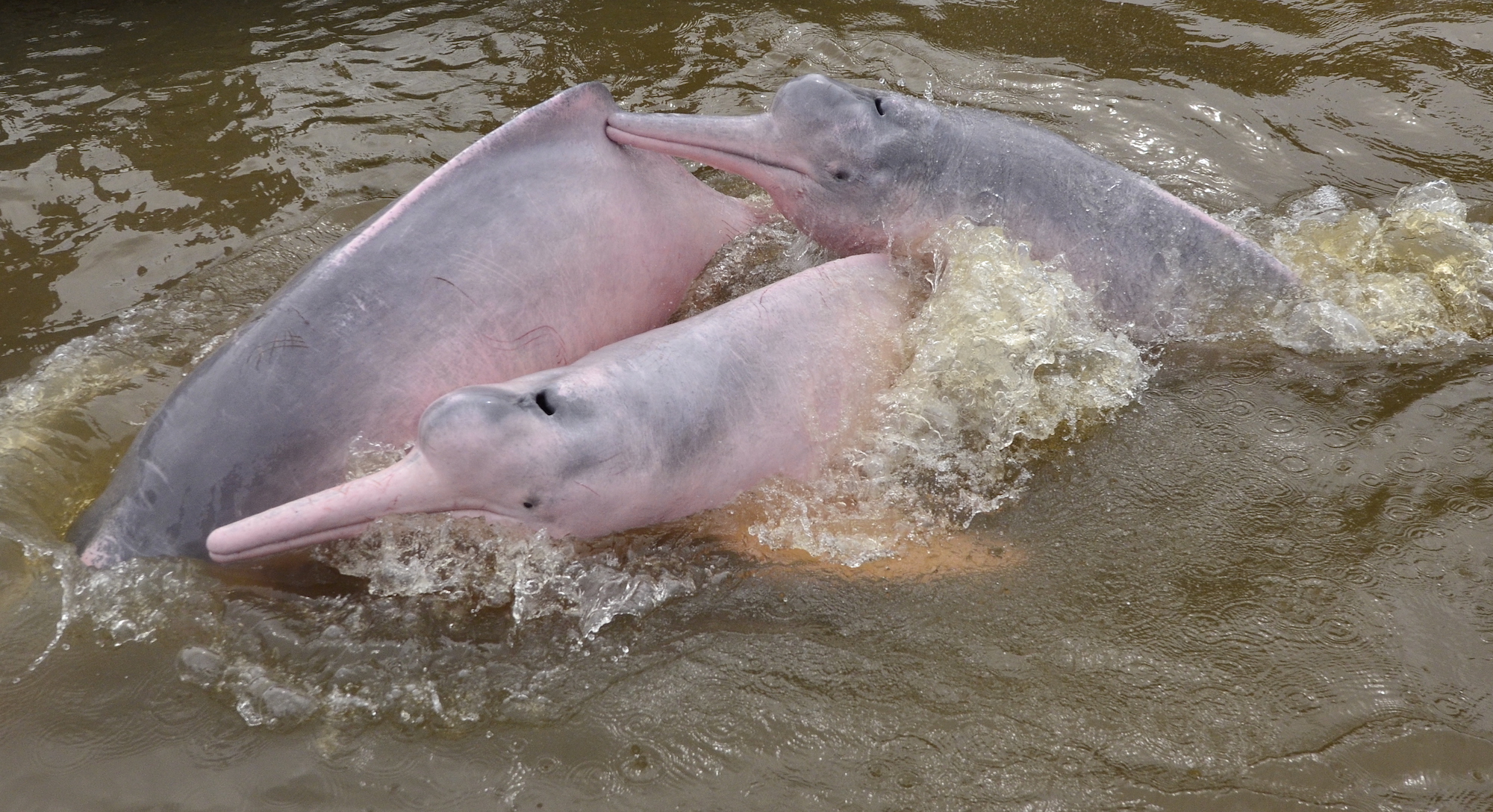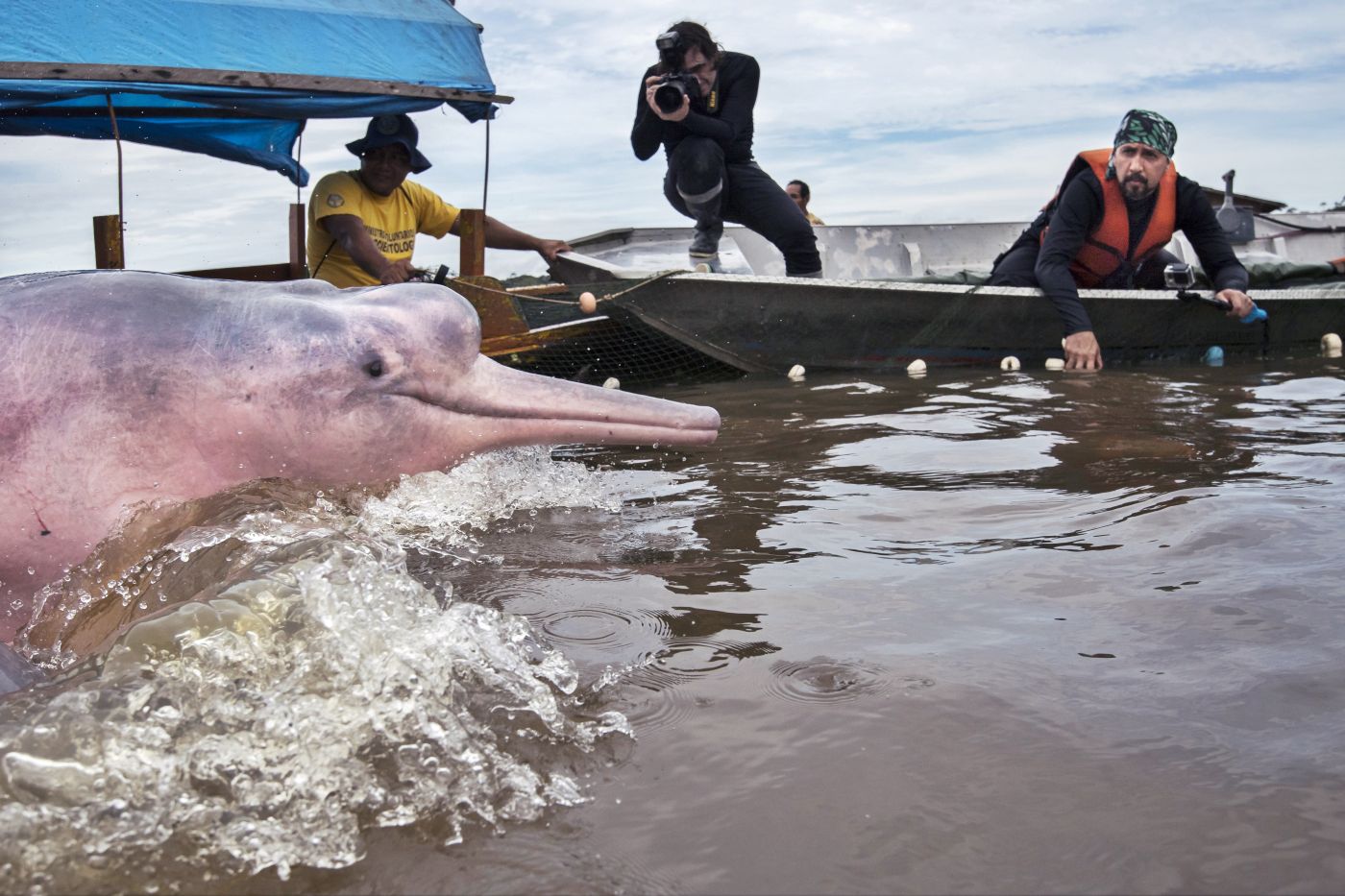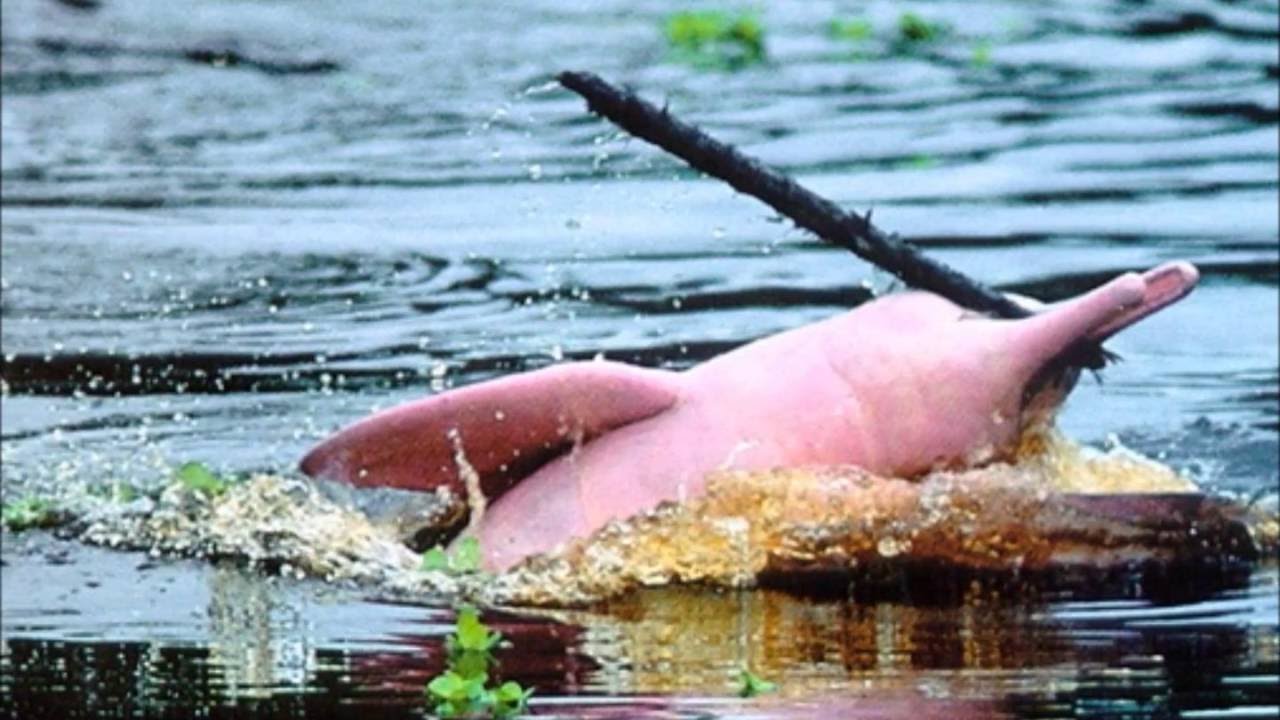The Amazon Dolphin is an incredible creature, with certain very outstanding characteristics, including the color of its skin. This pink river dolphin is the largest known in these waters. That is why in this article we are going to review its characteristics, feeding, reproduction, among other important information about this species. So I invite you to continue reading.

The pink dolphin
The pink dolphin has a wide variety of names such as Boto, Bufeo, Amazon Dolphin or even Tonina. But scientifically it is known as Inia geoffrensis, which is a species of mammal of the odontocete cetacean type. This exotic animal belongs to the Iniidae family and has two subspecies which are; Inia geoffrensis geoffrensis and Inia geoffrensis humboldtiana. These subspecies are distributed throughout the Amazon basin. It can also be found in the upper basin of the Madeira River in Bolivia and even in the Orinoco basin.
This species of dolphin is considered one of the largest river dolphins. Their weight tends to vary between 180 kg and 185 kg and they can measure up to 2.5 meters. As a distinctive feature when they enter the adult phase, the females take on a much more accentuated pink color than the males. This species of cetacean animal has a much more evident sexual dimorphism than in other species. Since males measure and weigh between 16% and 55% more than in the case of females.
Just like the other odontocetes, this one has an organ which is known as a melon, this organ is used for echolocation. As for its fins, we find the dorsal which is characterized by having very little height. But this is compensated for by its length, as for its pectoral fins they are characterized by being large. These peculiarities together with its size and with the lack of fusion of the cervical vertebrae. They are going to give them a great ability to maneuver so that they can move around their habitat and to be able to hunt their prey.
As for their food, they have a very wide diet to be of the genus of the odontocetes. Since these feed primarily on fish, which are of different types of species, approximately 53 different species have been calculated. Among these species we can find corvinas, tetras and piranhas. Even these pink dolphins or as they are also known Inia geoffrensis complete their diet through river turtles and crabs.
The pink dolphin can be found in the main tributaries of the Amazon River and the Orinoco River, these are found living below 400 meters above sea level. When there is a rainy season, the pink dolphins move to the flooded areas of the jungle. Since the vast majority of fish species move to these areas, which translates into a greater food source for the pink dolphin. Unfortunately, however, these wonderful creatures such as the pink dolphin are in serious danger of extinction.
As mentioned above, the pink dolphin entered the IUCN red list of endangered animals in 2008. However, no specific data is available on them. That is why it is due to this that there is great uncertainty regarding the total numbers of the population of the pink dolphin species. Nor is there more information regarding its trend and even about the negative impact caused by the disappearance of this species in the ecosystem.
Although at present this species of pink dolphin has not had a large number of significant hunting, the main factor for its decrease in numbers in terms of its population, will be the loss of its natural habitat. In addition to this factor, there is also another such as accidental capture for fishing purposes. Due to its peculiar characteristic, that is, its pink color, it is a species of odontocete kept in captivity in different aquariums around the world, among them we can find those in the United States, Venezuela and Europe. Although many have treated this species of pink dolphin, it is very problematic to train, and it also has a high mortality rate in captivity.
Taxonomy
The pink dolphin or as it is scientifically known Inia geoffrensis was discovered and described by Henri Marie Ducrotay de Blainville in 1817. It should be noted that, within the odontocetes, this pink dolphin is located in the superfamily Platanistoidea, which are known to be river dolphins. This superfamily is made up of two large families: Platanistidae and Iniidae. In which the latter is the one that belongs to the genus Inia, that is, our pink dolphin.
There is no further information on when these pink dolphins entered the Amazon basin. Some studies have concluded that they may have made it approximately more than 15 million years ago from the Pacific Ocean. Even several of these studies showed as a result that it is possible that they entered before the Andes were formed or there may also be a probability that it is much more recent from the Atlantic Ocean.
Of this species of animal, 3 subspecies will be identified, which are; I.g. geoffrensis, I.g. boliviensis and I.g. Humboldtian. But according to studies carried out in 1994, in each of these species in terms of skull morphology, the subspecies I. g. boliviensis it was concluded that it belonged to a different species. In 2002, a series of examinations of the mitochondrial DNA of specimens from the Orinoco basin, the Putumayo river (tributary of the Amazon) and the Tijamuchy and Ipurupuru rivers and even in the Bolivian Amazon were carried out, where it was concluded that the genus Inia It was divided into two evolutionary units.
One of these evolutionary units is restricted to what are the river basins of Bolivia and the other is widely located in the Orinoco and Amazon basins. However, even in 2009 this problem remained unresolved. In their different location sites they will receive different common names such as; pink dolphin, boto in the Amazon, Amazon dolphin, bufeo in Colombia and Peru and finally tonina in the Orinoco. All this will depend on its location, which is why it tends to have several names.
Subspecies
We found the subspecies Inia boliviensis in Rurrenabaque, in the Beni department of Bolivia. This species was treated as part of the Inia geoffrensis subspecies, the latter of which is found in most of the Amazon River. We can also find this subspecies in the rivers Tocantins, Araguaia, the lower Xingú and Tapajós, the Madeira including the rapids of Porto Velho. Likewise, you can find the Purús, Yuruá, Ica, Caquetá, Branco rivers and even the Negro River along the entire length of the Casiquiare channel to San Fernando de Atabapo on the Orinoco River.
The subspecies Inia geoffrensis humboldtiana can be found in the Orinoco river basin, also including the Apure and Meta rivers. Relationships between this subspecies and its peers are limited, at least in the dry season, and this is due to the waterfalls of the Negro River. Also through the rapids of the Orinoco River between what is known as Samariapo and Puerto Ayacucho and even through the Casiquiare channel. As for the third subspecies Inia geoffrensis boliviensis, its population is distributed in the upper basin of the Madeira River. This species of pink dolphin can also be found in the Teotonio streams, in Bolivia.
It is here that it was insinuated that it was granted to the full species, that is, Inia boliviensis. But due to its low genetic inheritance and the demonstration that occurs in terms of the Teotonio rapids, they will not certify the genetic isolation with the presence of the specimens of the I. boliviensis species, located in the lower basin of the Madeira River. These species are still considered subspecies of the pink dolphin, both by the Society of Marine Mammalogy and the IUCN.
They also state that they do not have much information or conclusive data that they can contribute to their studies. It is only known that they are confined to the Mamoré River, whose main tributary is the Iténez, adding the lower zone of its tributaries, which will vary between 100 and 300 meters above sea level.
Many studies have concluded that these species of pink dolphin are isolated from populations of Inia geoffrensis. This is due to the 400 km of rapids that run from Porto Velho, over the Madeira River, to Riberalta, which passes over the Beni River in Bolivia. Despite this, there are pink dolphins of subspecies that are not determined in the Abuná River and its dependent which is the Negro River in Bolivia. This river is the one that crosses the Madeira/Beni system at the border point between Brazil and Bolivia.
Description
The pink dolphin or as it is also known as El Boto, is considered the largest river dolphin that lives in these waters. In terms of size, we found that adult males reach a length and weight of approximately 2.55 m. Although there are averages such as 2.32 m, in terms of weight it is approximately 185 kg. With an average for these species of 154 kg. But in females these measurements and weight tend to vary, reaching up to 2,15 m with an average of 2.00 m and weighing 150 kg with an average of 100 kg.
As we have already mentioned before, this species of animal is one of the cetaceans with the greatest sexual dimorphism. By this we mean that males are between 16% and 55% heavier than females. Being in this way the only one among the river dolphins, in which the male is by general nature much larger than the females. As for his skin or body texture, he is robust and very strong, but despite this, he is quite flexible. A very important difference between the pink dolphin, which is a river dolphin and an oceanic dolphin, is that its cervical vertebrae are not fused.
This is what will allow this animal species to be able to move its head in a wide variety and range of movements. As for its caudal fin, it is characterized by being wide and triangular and its dorsal fin, which has a keel shape, has little height, but is very elongated and extends from the middle of the body of these dolphins to its caudal region. When we talk about pectoral fins, they are characterized by being large and having an oar shape. The length of these fins gives it the ability to perform circular movements, which will give it exceptional maneuverability. This feature will allow you to swim through the flooded vegetation. But due to this particularity, it will cause a decrease in the speed of your swim.
As for his peculiar skin color, it can be explained according to studies, that this color tends to vary due to his age. Newborns and youngsters will have a dark gray skin tone. As soon as they start in the adolescent stage, this skin color will transform from a dark gray tone to a light gray and when they step on their adult stage, their skin turns a pinkish color. This is due to the consequences of repetitive abrasion of the skin surface. In males, this skin tone is much pinker than females, since they have a much more frequent trauma due to the same intraspecific aggression, that is, between two specimens of the same species.
Skin color in adults, as we already know, will vary between solid pink and mottled. In some adult specimens the skin tone on the dorsal surface is much darker. It is believed that this color difference will depend on the temperature, the transparency of the water and even its geographical location. There are some exceptions of some specimens where their hue is completely albino, these were kept in captivity for years in aquariums, where unfortunately, their life is shortened since they do not adapt to it.
The skull of the pink dolphin is slightly asymmetrical, unlike the other species of the odontocete type. This one has a prominent snout, with about 25 to 28 pairs of long and finite teeth on each side of the jaws. Their dentition is considered heterodont, by this we mean that the teeth will differ in terms of their shape and length. As for its front teeth, they are conical and the back ones have ridges on the inside of the crown. They have small eyes, but this does not mean that they do not have good vision in and out of the water, on the contrary, their vision is very good.
On its forehead it has a melon-shaped protuberance, which is small in size. But this form is not always the case, since the pink dolphin has the ability to modify it through muscular control. This only happens when the pink dolphin uses its echolocation ability. This species has a prominent snout, which will be long and thin with approximately 25 to 28 pairs of teeth in the hemimaxillae. Their front teeth are very pointed, while their back teeth are much flatter and more cupped.
These types of teeth will serve the pink dolphin for various purposes, such as imprisoning its prey in order to crush it. As for its breathing, the pink dolphin will breathe in a period of time that goes between 30 to 110 per second. It also has the peculiarity of launching a jet of water that goes up to 2 meters high, through the dorsal hole that they have. When talking about its gestation period, it lasts 315 days. After this period of time, when the calf is born, it will remain next to the mother for approximately two years.
Biology and Ecology
In this section of the article we are going to talk in more depth about the characteristics that are going to define the pink dolphin. Everything related to their longevity, behavior, reproduction, diet and even their communication with their other species partners will be explained to them. So I invite you to continue reading much more about the following determining characteristics of the pink dolphin.
Longevity
The life span or life expectancy of the pink dolphin in nature is unknown, there is no conclusive data regarding this unknown. But when talking about the life expectancy of the pink dolphin in captivity, records of this species are found in these spaces. Some of these specimens in captivity have a life expectancy of between 10 to 31 years. However, the average longevity in this species in captivity is only 33 months.
But the same does not happen with all species in captivity, a specimen known as Apure which was kept in the Duisburg Zoo, Germany, managed to live more than forty years. Which thirty-one of them were in captivity. Another specimen whose life expectancy in captivity is calculated is a specimen which was about 48 years old, where it was in captivity until its death in 2016. This specimen was known as Dalia, which was a dolphin from the Valencia aquarium located in Venezuela.
Behavior
The pink dolphin is considered by many studies a solitary species, which is not very common to see them in groups or herds. But there are some exceptions and when this happens they congregate in associations of up to 4 individuals. In these cases it is normal to observe groups of couples and children, but there can also be some exceptions where the groups can be made up of heterogeneous or only males. There are some exceptions where much larger groups can be observed as they are areas of abundant food.
An example of this is the mouths of rivers, this group can also come to this area to rest and even socialize. While the females with their young are located in the flooded areas of the rivers. But when there is a dry season this separation does not happen. Everything that has been explained above is the final result of the research carried out on this animal, that is, the pink dolphin. In these studies it is also said that the species found in captivity have shown that the pink dolphin is less shy than its similar, that is, the bottlenose dolphin.
Not only are they less shy, but they are also less sociable with their peers. It has a very low rate of aggressiveness, is much less playful and even shows little aerial behavior than the bottlenose dolphin. It is also considered to be a very curious animal and is characterized by not showing fear of strange things or objects. However, it is likely that when this species is in captivity it will not behave in the same way as when it was in its natural habitat.
When the pink dolphin is in the wild, it tends to have an infinity of behaviors. Among them we can find that they hold the oars of the fishermen, they rub against the boats, they tend to uproot the plants that are under the water. They also throw sticks and even play with the logs, clay, turtles, snakes and even play with the fish.
As for this species, it is characterized by being a slow swimmer. Its maximum speed will vary in terms of its displacement between 1,5 and 3,2 km / h. But it will record speeds that even reach 14 and 22 km / h. But he is also capable of swimming fast for a long time. When this animal emerges, the tip of the snout, the melon and its dorsal fin appear in parallel. Regarding their behavior, they rarely take their tail out of the water before they dive.
Another trait in their behavior is that they can shake their fins, stick out their tail fin and even stick their head out of the water, this last action is done to be able to observe their surroundings. Very rarely does it jump on the surface of the water. But there are some exceptions where it is the young people who can perform this pirouette, managing to separate themselves from the water up to a meter high. It has been determined that this species of dolphin, that is, the pink dolphin, is much more difficult to train than most of them.
Reproduction
Regarding their reproduction, females reach their sexual maturity between 6 to 7 years of age. This occurs when they are in a size of 1,75 to 1.80 meters. Unlike the males, which reach their stage of sexual maturity much later and especially when they reach their size of two meters in length. Its period or stage of reproduction is mediated by the seasons, this stage will coincide with what is known as the dry season. By this we mean when the water level is very low.
As for the duration of gestation, it will extend to eleven months. The calving period is going to occur in what is known as the flood season. As for the pups that are born, they will weigh approximately 80 kg and their lactation period will last up to a year. The pink dolphin has a time interval that will vary between two to three years in each of its pregnancies. Long before knowing that the species had marked sexual dimorphism, it was suggested that pink dolphins were monogamous.
Then over time it was shown that the males were much larger than the females. After various studies carried out during its mating and reproduction period, this species was documented with very aggressive sexual behavior, both in its natural habitat and in captivity. During these situations, the vast majority of males will present various injuries and damages. Above all, in its dorsal, caudal, pectoral fins and even the spiracle due to bites. Various secondary scars may also be noted due to tooth raking.
The results of these studies explain that this aggressive sexual behavior is shown as a kind of fierce competition in order to court the female and thus get closer to her. With this it can be indicated that her reproduction consists of a polygamous mating system. But even with this it is not ruled out that they may be polyandry and promiscuous. In these captive animals, their courtship and their games prior to mating have been studied. It can be seen that the males are the ones that take the first step.
By this we mean that they take the initiative, they do this through small bites on the fins of the females. But if it happens that the female is not receptive to this courtship, she can react violently, that is, aggressively. An increase in the frequencies in their copulations have been studied. In these studies that have been carried out in captivity, a pair of these specimens copulated 47 times in a period of 3 to 5 hours. These studies have been carried out using three different positions. Placing the belly in contact at a right angle resting parallel head to head or head to tail.
As already said, the breeding season is seasonal and whose births occur between May and June. In story the time of births will coincide with the flood season. This can give females and even their young an advantage so that they can stay in flooded areas much longer than males. At the first moment that the water in this area begins to decrease, the number of dams in these flooded areas will increase due to the great loss of space. This will help infants without spending a lot of energy to be able to feed according to the demand that their body needs for their growth.
This gestation time is estimated at approximately eleven months and the delivery time, according to the study that has been carried out in captivity, will take between 4 to 5 hours. For each gestation, only one calf will be born, when the umbilical cord is barely broken, the mother proceeds to help her calf to come to the surface so that they can breathe. The measurements that these pups have at birth is approximately 80 cm long. While in captivity, according to the studies carried out, they explain that its annual growth will be 0,27 m.
As for its lactation time, it will take about a year and there have even been registered pregnant females that will continue to lactate. The period of time that will take between births is estimated to be between 15 and 36 months. As for the duration of the aging, it will be extended from 2 to 3 years. This period will allow for strong bonds to develop and good relationships to develop.
The relative permanence that occurs during lactation, including parenting, suggests a strong bond between mother and child. In the studies that have been carried out on the vast majority of the pairs under study in their natural habitat, they are made up of a female and her offspring. This gives us to understand that the long periods of parental care will help to develop the learning and development of the young calf, as does the bottlenose dolphin.
Diet
When talking about the diet of the pink dolphin, there is a great diversity of food greater in any other odontocete. This diet will be made up of more than 43 different species of fish, which are grouped into 19 families. The size of their prey varies between 5 to 80 cm, but they will always have an average size of 20 cm. The fish that are eaten most frequently are those that make up the family Sciaenidae (corvinas), Cichlidae and Characidae (tetras and piranhas).
But thanks to its heterodont teeth it will allow it to have access to those prey that have a shell. As are the scientifically known river turtles Podocnemis sextuberculata and crabs with the scientific name Poppiana argentiniana. Their diet is much more diverse during the wet season, this is the season when the fish are distributed in the places that are flooded outside the river channels. For this reason it becomes much more difficult to catch for this reason it becomes much more selective during this dry season.
This species normally hunts alone and are active both day and night. But according to research carried out, this species normally hunts between 6 and 9 in the morning and in the afternoon between 3 and 4 pm. As for food consumption, they reach about 5,5% of their body weight per day. This species is almost always found near waterfalls and even at the mouths of rivers. In this period of time is when the schools of fish break up, this allows them to be much easier to hunt.
They even take advantage of the alterations made by the boats to hunt their disoriented prey. On some occasions they even collaborate with tucuxis (Sotalia fluviatilis) and giant otters (Pteronura brasiliensis) so that they can coordinate hunting. This makes the job much easier, thus making it easier to gather and attack schools of fish at the same time. With this it can be concluded that there is little demand for food among these species, since each of these species prefers different foods. And it has even been seen that the pink dolphin that is in captivity will share food.
Communication
This species of pink dolphin, as with other dolphins, will use a series of tonal whistles to communicate. The reproduction of this series of sounds is linked to the moment in which they return to the surface. Long before the dives are made, this is related in the investigations carried out with feeding and hunting. As for the acoustic analysis, they have shown that the vocalizations are very different from the conformation of the typical whistles of the delphinid population. Including in this way its relative, the tucuxi.
Distribution and Population
When talking about the distribution and population of the pink dolphin, it will cover a great variety of information and even then there are inconclusive data. As explained above, the pink dolphin is one of the largest in the rivers, and they are also much more abundant. These have a wide distribution within their natural freshwater habitat. They can be found distributed in 6 countries of South America which are; Bolivia, Brazil, Colombia, Ecuador, Peru and Venezuela. So its presence can be located in an area of approximately 7 million km².
They are distributed throughout the Amazon River and its main tributaries, including small tributaries and surrounding lakes. From the mouth near Belén to its origin in the Marañón and Ucayali rivers in Peru. They have limits that are established by impassable waterfalls, such as those of the Xingú and Tapajós rivers in Brazil and in shallow water. In addition, the series of rapids and waterfalls of the Madeira River have contributed to the isolation of the population known as the subspecies I. g. boliviensis, located south of the Amazon basin.
The pink river dolphin is distributed along the Orinoco river basin, except for the Caroní river and the upper part of the Caura river in Venezuela. The only link between the Orinoco and the Amazon is through the Casiquiare channel. The distribution of the dolphins in the rivers and surrounding areas will depend on the time of year. When there is a dry season they are going to be located in the riverbed. But when there are rainy seasons, when the rivers overflow, they proceed to disperse in the flooded places. As well as the forests (igapó) as well as the plain that are flooded.
Regarding the investigations carried out to be able to locate the population of the pink dolphin, it has turned out to be very difficult to analyze said data, this is due to the great difference in the methodology used. In an investigation that was carried out in the section of the Amazon River known as the Solimões River, which has a length of 1200 km that runs between the city of Manaus and Tabatinga. It has a population of 332±55 specimens sighted during each inspection, in terms of its density it is calculated at 0,08-0,33 animals per km² in the main channels. But unlike the main channels, we find a density of 0,49-0,93 in the branches.
In other study investigations carried out in a certain section of 120 km at the confluence of Colombia, Brazil and Peru. 345 individuals were observed with a density of 4,8 in the tributaries. A 2,7 in the vicinity of the islands and a 2,0 along the entire length of the shore. Additionally, another investigation was carried out in the Amazon at the mouth of the Caquetá River, which was carried out for 6 days in a row. Said investigations showed as a result that there was a much higher density on the banks of the rivers with 3,7 of this species per km², in which it decreases towards the center of the river.
Regarding studies carried out during the rainy season, a density has been observed in the flooded plains, with a number of 18 animals per km². As for the banks of rivers and lakes, it was stipulated between 1,8 to 5,8 specimens per km². Due to these research results, it is concluded that the pink dolphin is found in a higher density than any other cetacean. In the year 2002, 208 dolphins were recorded in the Tijamuchi River, in Bolivia.
In 2004, it was suggested that the number of species in the middle course of the Amazon was structured in the foundations of the floodplain systems, which have an intense movement between them. A population of approximately 13000 pink dolphins was estimated in the 11 m². This was accounted for in the Mamiraua Sustainable Development Reserve, which encompasses an approximate 240%-11% of the várzea environment in Brazil.
Habitat
The pink river dolphin can be found mainly in the main branch of the Amazon River, near Fonte Boa, Brazil. They can be seen in the various flood zones, such as the lagoons and minor channels. This is the natural habitat of the pink dolphin throughout the year. In the river basins where the pink dolphin can be observed, all habitats can be located. In this you can locate the main courses of rivers, canals, the mouths of tributaries, lakes and the end of rapids and waterfalls.
What will determine this are climate changes, this will influence the level of the rivers during the rainy season and even during the drought throughout the year. All this determines which are the areas that can be occupied and which have food for their sustenance. In the dry season, the specimens are located in the main riverbeds. This is because the shorter channels are shallower and the dams are located along the river limits. This is why this species is responsible for migrating to places with abundant food.
During the rainy season, the pink river dolphin can move very easily to the much smaller tributaries. They can even move to the jungle and flood plains. As for males and females, they have a great preference when selecting their habitat. For example, in the case of the males, they return to the main channels of the rivers, when the water level remains high. In the case of the females, together with their offspring, they stay much longer in the flooded places.
Now you may be wondering why the mother and her calf stay much longer, because this has different reasons or reasons. This type of water, which is very calm, will allow young people to expend little energy, allows them to rest, breastfeed and will even encourage them to obtain food in a less demanding environment. This environment will be away from those river currents that can be counterproductive for breeding. It also decreases the danger of male aggression towards the young and even predation by other species on this species.
Cloud ERP Implementation
In the Pacaya Samiria National Reserve, which is located in Peru, photo-identification has been used in order to know the specimens under study. They do this through patterns of pigmentation, scars, and alterations in the beak. 72 specimens can be located, of which 25 were located between 1991 and 2000. The intervals between each of their sightings are calculated to vary between 1 day and 6 to 7 years. As for its maximum movement limit, it was approximately 120 km, with an average of 60,8 km.
According to the studies carried out on these species, the greatest distance recorded in one day was approximately 120 km, with a range of 14,5 km. In another study that was carried out in the center of the Amazon River, in which it was developed in the center of this place, it was possible to observe that the dolphins moved only a few tens of kilometers. This behavior occurred more than anything between the dry period and the times of flooding. Despite this, only 3 of the 160 registered animals were only located more than 100 km from the place where they were last seen.
Conservation
We had already mentioned that this species of pink dolphin was added to the red list of threatened species. This red list is carried out by the IUCN, in which various species are added in which they present a status of DD, that is, insufficient data. However, before the pink dolphin was placed on the red list, it was previously listed as “Vulnerable”. But due to the status of the pink dolphin species and regarding the limited information on this species, in terms of threats, ecology and population trends.
As for the areas where dolphins have been studied, it seems that they are well extended and even quite abundant. However, these areas will only represent a small proportion of the complete distribution of the specimens. In these sites this species is mainly protected. Despite this, the information that can be obtained from these areas may not be representative and may not even be valid in the future.
But due to pollution and slow destruction of what is their natural habitat. In other words, the Amazon jungle and even the vulnerability of the species. That is why a series of measures have been taken to protect them in all the countries in which the species inhabit. The factors that influence its threat is deforestation and those human practices that will have a negative influence. Thus altering their environment. One of the main sources of concern is going to be the difficulty in keeping captive species alive.
This is due to intraspecific aggression and the longevity of the species during its captivity is also included. This is why if the numbers of pink dolphins begin to decline to very dangerous levels in their natural habitat, there would be a much higher risk of becoming extinct because of how difficult it is to keep them in captivity for a much longer period. It is in 2008, the International Whaling Commission (IWC) informed and raised its concern about the hunting of pink dolphins. Where it is used as bait in the Central Amazon.
This is what produces a large outgoing problem that has spread on a large scale. The pink dolphin species is attached to Appendix II of the Convention on International Trade in Endangered Species of Wild Fauna and Flora (CITES). The species was also included in Clause II of the Convention on the Conservation of Migratory Species of Wild Animals.
According to research conducted by the Scientific Committee of the International Whaling Commission in 2000, the population numbers of pink dolphins are much larger. They also state that there is little information and evidence on the decline in population numbers and also the area of distribution. But despite this, they also recognize the problem that there is about the intervention of human beings in the natural habitat of this species. That is why they determine that in the near future this will be a probable cause in terms of the future decrease in its population.
According to research conducted by the Scientific Committee of the International Whaling Commission in 2000, the population numbers of pink dolphins are much larger. They also state that there is little information and evidence on the decline in population numbers and also the area of distribution. But despite this, they also recognize the problem that there is about the intervention of human beings in the natural habitat of this species. That is why they determine that in the near future this will be a probable cause in terms of the future decrease in its population.
For this reason, a series of recommendations were established in order to guarantee adequate monitoring for the species. Some of these recommendations include the application and publication of research on population composition. A record of the distribution of the species is also carried out, keeping a clear record of the potential threats that have a strong impact on this species. Some of these are large-scale fishing operations and the location of oil pipelines. There is also a much more detailed record of the risks, distribution and quantity of each of the species.
Threats
The pink dolphin, as explained above, is on the red list of endangered animals. This is why this species has been protected and respected. However, hunting, trapping, accidental fishing and even the destruction of their natural habitat have now been on the rise. All these factors will contribute to the decrease in the number of the pink dolphin population. This is why several associations are devising measures to combat these problems that lead this species to extinction. Next, we are going to talk about the factors that influence the threat.
Hunting and deliberate killings
As mentioned before, this species has been protected and even respected, but unfortunately these values have been lost today. Since for many selfish actions on the part of the human being this species has been compromised. Some of these problems are the records of the use of its oil, this liquid is used as a light source. As for hunting, the Muran Indians were in charge of hunting them near Manaus, Brazil. This species is also hunted as test objects to make medicine and even love charms. Among other reasons why they are unfairly hunted by the selfishness of human beings.
Accidental Catch
The use of nylon fishing nets has increased incidental catches of pink dolphins. This method, which has been used since 1990, was spread with the aim of capturing «piracatinga» (Calophysus macropterus). Taking this to the worst threat to the species. Another threat that also impacts the pink dolphin is related to the construction of hydroelectric plants in the main tributaries of the Amazon. This causes a decrease in fish species, which is why there is not enough food for the dolphin species.
Another important factor in the threats against this species is the construction of dams that will isolate the various populations. Causing there to be a decrease in genetic exchange, leading to an increase in the possibility of local extinctions. Unfortunately, this causes the pink dolphins not to reproduce and therefore there will be no new offspring to continue with their lineage.
overfishing
As explained above, the increase in nylon fishing nets throughout the Americas has affected these species. The pressure exerted by fishing also creates a kind of much more intense competition between the dolphins and the fishermen themselves for the fish. According to studies carried out on pink dolphins, it has been established that their diet is based on only 43% of the 53 species of fish that are marketed by the fisherman. So the fish that are caught are not going to be big enough for there to be a commercial interest.
Habitat Degradation
The degradation and contamination of the pink dolphin habitat is one of the main factors influencing the threat against this species. One of the factors that contributes to the degradation of the pink dolphin's habitat is obtaining wood from deforestation in the Amazon rainforest. This is one of the consequences derived from the presence of human beings and their selfish actions. These same actions are what will contribute to the loss of their habitat.
The human being has been expanding rapidly throughout the distribution area and location of the pink dolphin. Above all, in the areas of Colombia and Brazil. The presence of human beings produces an increase in agricultural activity along with deforestation, livestock and even plantations. Regarding the deforestation of floodplains in order to continue with agricultural activities and even for the lumber industry. This leads to problems affecting the hydrological cycle and the riparian ecosystem.
One of the main consequences caused by deforestation is the decrease in the multiplication of the fish population. This causes the food supply for dolphins and other predators to be limited and restricted. Another potential cause of the alteration of the habitat of this species is the construction of hydroelectric plants. These architectures are going to be a major obstacle for the migrations of the species and even of its prey. This produces a limit to access to food and favors the isolation or division of the different populations.
Predators
There is currently no record of the natural order predators of the pink river dolphin. But it has been said that the black caiman (Melanosuchus niger), the bull shark (Carcharhinus leucas), the anaconda (Eunectes murinus) and the jaguar (Panthera onca) can be potentially dangerous for the pink dolphin. Since these can easily capture this species. Some animals have been found to have crescent-shaped scars that are linked to catfish of the Cetopsidae and Trichomycteridae families.
If you were interested in this topic of the Pink Dolphin, I also invite you to continue reading the following articles:
